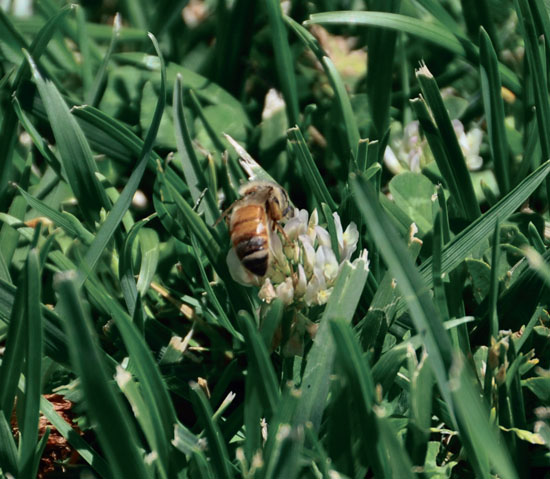|
|
Published June 29, 2016
|
Bee Stings Can Be a Painful Part of Summer
|
|
| By Cathy Dausman |
 |
| Honey bee on clover flower could sting when stept on Photo Andy Scheck |
Summer is a time of lazy, hazy, crazy days as Nat King Cole once sang. But going barefoot in the park or poolside might include an unwanted rebuke from a fuzzy flying insect known as the honey bee.
 Bee stings, as well as stings from other animals often mistaken for the honey bee (hornets, wasps and yellow jackets, for example), contain a small amount of venom that causes a local toxic reaction in all people and an allergic reaction in those previously sensitized. According to the Centers for Disease Control and Prevention thousands of people are stung by insects each year, while an estimated 90 to 100 people in the United States die as a result of allergic reactions.
Bee stings, as well as stings from other animals often mistaken for the honey bee (hornets, wasps and yellow jackets, for example), contain a small amount of venom that causes a local toxic reaction in all people and an allergic reaction in those previously sensitized. According to the Centers for Disease Control and Prevention thousands of people are stung by insects each year, while an estimated 90 to 100 people in the United States die as a result of allergic reactions.
 Here is the buzz on how to avoid getting stung, and what to do if stung:
Here is the buzz on how to avoid getting stung, and what to do if stung:
 European honey bees are not native to North America but have wholeheartedly adapted to this continent. As the sun warms their hive, they're out for the day gathering pollen, searching for sweets to convert into honey. It takes two million flower visits to produce a pound of honey. Normally single-minded enough to allow curious humans to approach if they remain calm and quiet, a bee can be distracted by the presence of sweet drinks, fruit or food stains on clothing. They may also mistake your loose hair for a honey-stealing furry animal, so wearing a hat could help. Bees trapped inside straws, soda cans, under morsels of food, under clothing or underfoot quickly object and make their presence known.
European honey bees are not native to North America but have wholeheartedly adapted to this continent. As the sun warms their hive, they're out for the day gathering pollen, searching for sweets to convert into honey. It takes two million flower visits to produce a pound of honey. Normally single-minded enough to allow curious humans to approach if they remain calm and quiet, a bee can be distracted by the presence of sweet drinks, fruit or food stains on clothing. They may also mistake your loose hair for a honey-stealing furry animal, so wearing a hat could help. Bees trapped inside straws, soda cans, under morsels of food, under clothing or underfoot quickly object and make their presence known.
 A small stinger at the wound site confirms the culprit was a honey bee. Bees sting once, lose their barbed stingers and die within 15 or 20 minutes; hornets, wasps and yellow jackets are repeat offenders who retain their stingers. Moraga-Orinda Fire District firefighter-paramedic Jeff Keena says the frequency of bee stings does pick up this time of year, although MOFD is usually involved only when the victim has a moderate to severe reaction. Symptoms of such a reaction may include swelling of the lips, eyes or throat, elevated heart rate, nausea, wheezing or difficulty breathing. If this happens, call 911. Paramedics and those with serious allergies carry what Keena calls the "big ticket" item - epinephrine; which when administered brings relief within 60 seconds.
A small stinger at the wound site confirms the culprit was a honey bee. Bees sting once, lose their barbed stingers and die within 15 or 20 minutes; hornets, wasps and yellow jackets are repeat offenders who retain their stingers. Moraga-Orinda Fire District firefighter-paramedic Jeff Keena says the frequency of bee stings does pick up this time of year, although MOFD is usually involved only when the victim has a moderate to severe reaction. Symptoms of such a reaction may include swelling of the lips, eyes or throat, elevated heart rate, nausea, wheezing or difficulty breathing. If this happens, call 911. Paramedics and those with serious allergies carry what Keena calls the "big ticket" item - epinephrine; which when administered brings relief within 60 seconds.
 If the bee sting reaction is confined to the site and consists only of a mild rash or itching, first aid treatment is to move away from where the sting occurred, remove the stinger by scraping it out (a credit card works well), washing the wound area, applying ice and treating it with over the counter medications like antihistamines or aspirin substitute.
If the bee sting reaction is confined to the site and consists only of a mild rash or itching, first aid treatment is to move away from where the sting occurred, remove the stinger by scraping it out (a credit card works well), washing the wound area, applying ice and treating it with over the counter medications like antihistamines or aspirin substitute.
 Dogs as well as humans are at risk for bee stings. Moraga's Nancy Bennett has both a husband and a dog with known bee allergies.
Dogs as well as humans are at risk for bee stings. Moraga's Nancy Bennett has both a husband and a dog with known bee allergies.
 "Peter (Bennett's husband) keeps an epi-pen, and Snowball (their golden retriever) had difficulty breathing after getting stung. We had to take him (Snowball) to the vet," she said. Dogs are usually stung on their nose or paws, said Four Seasons Animal Hospital veterinarian Dana Schaffer. A stung dog may try to rub the affected area, and may develop swelling or pain around its muzzle. Dogs, too, can be treated with epinephrine, but the dosage must be prescribed by a vet and administered by owners only after proper instruction. Schaffer suggests those who plan to hike with their dog off leash carry a proper dosage of antihistamine prescribed by a vet for Rover. She recommends that any dog who has been stung be taken to the vet.
"Peter (Bennett's husband) keeps an epi-pen, and Snowball (their golden retriever) had difficulty breathing after getting stung. We had to take him (Snowball) to the vet," she said. Dogs are usually stung on their nose or paws, said Four Seasons Animal Hospital veterinarian Dana Schaffer. A stung dog may try to rub the affected area, and may develop swelling or pain around its muzzle. Dogs, too, can be treated with epinephrine, but the dosage must be prescribed by a vet and administered by owners only after proper instruction. Schaffer suggests those who plan to hike with their dog off leash carry a proper dosage of antihistamine prescribed by a vet for Rover. She recommends that any dog who has been stung be taken to the vet.
 Beekeeper Rusty Burlew says that the sting from a European honey bee packs a punch. The blogger, columnist, speaker and director of the Native Bee Conservancy has been called as an expert witness in alleged bee sting court cases. She says honey bees often get a bad rap, having been confused with yellow jackets or wasps, whose population swells in the fall. Honey bees are drawn mostly to nectar and pollen while yellow jackets and wasps are carnivores who feed on the insects surrounding fallen, rotting fruit. That is why Burlew suggests those with bee allergies avoid orchards in the fall, when yellow jackets and wasps are out in full force. In those cases, Burlew says it's almost always a wasp that stings."
Beekeeper Rusty Burlew says that the sting from a European honey bee packs a punch. The blogger, columnist, speaker and director of the Native Bee Conservancy has been called as an expert witness in alleged bee sting court cases. She says honey bees often get a bad rap, having been confused with yellow jackets or wasps, whose population swells in the fall. Honey bees are drawn mostly to nectar and pollen while yellow jackets and wasps are carnivores who feed on the insects surrounding fallen, rotting fruit. That is why Burlew suggests those with bee allergies avoid orchards in the fall, when yellow jackets and wasps are out in full force. In those cases, Burlew says it's almost always a wasp that stings."
 For more information, visit these websites: www.honeybeesuite.com; www.diablobees.org, www.veterinarypartner.com, www.insects.about.com/od/antsbeeswasps/a/10-tips-to-avoid-bee-stings.htm
For more information, visit these websites: www.honeybeesuite.com; www.diablobees.org, www.veterinarypartner.com, www.insects.about.com/od/antsbeeswasps/a/10-tips-to-avoid-bee-stings.htm


|
|
|
|
|
|
|
|
|
|
|
|
|
|



